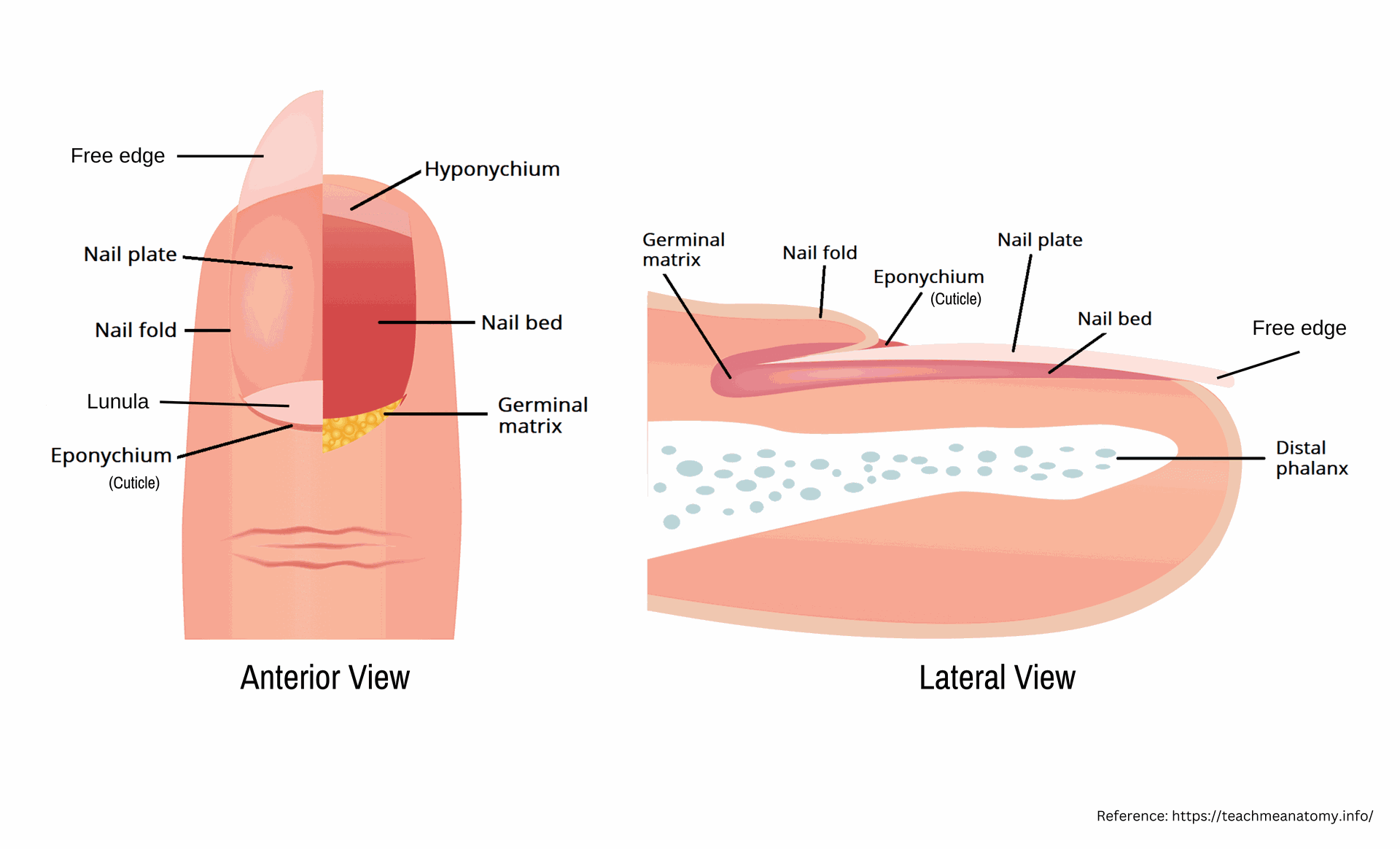-
INTRODUCTION
-
- Join this Course to access resources
-
CHAPTER 1 - NAIL ANATOMY AND HEALTH: UNDERSTANDING THE FOUNDATION
-
CHAPTER 2: PROFESSIONALISM IN PRACTICE: ETHICS, COMMUNICATION, AND WORKSPACE SETUP
-
CHAPTER 3 - E-FILE TRAINING
-
BONUS LESSON: STERILIZATION
-
- Join this Course to access resources
-
-
CHAPTER 4 - CUTICLE CARE
-
CHAPTER 5: GEL POLISH TRAINING
-
CHAPTER 6: GEL PRODUCT APPLICATION
-
CHAPTER 7: FINAL TOUCHES
-
- Join this Course to access resources
-
FINAL PREPARATIONS AND GUIDANCE
-
RECERTIFICATION
-
EVALUATION
-
CERTIFICATION
Understanding Nail Anatomy: A Comprehensive Guide
As a nail technician, having a solid understanding of the nail anatomy is crucial for providing excellent care and services to your clients. Knowing the different parts of the nail will not only enhance your technical skills but also allow you to address various nail concerns effectively. Here's a simple guide to nail anatomy:

The nail unit consists of the nail plate and the surrounding soft tissues:
- Nail plate – outer portion of the nail unit, formed by layers of keratin. It forms a hard, yet flexible, translucent plate.
- Nail folds – skin that surrounds and protects the proximal and lateral margins of the nail plate
- Nail bed (sterile matrix) – lies underneath the nail plate, attaching it to the distal phalanx. The nail bed provides a smooth surface for the growing nail plate to slide over (it does not contribute to plate growth itself).
- Germinal matrix – area of soft tissue proximal to the sterile matrix. Cells within the germinal matrix divide and become keratinised to form the nail plate. Continuous cell division within the matrix ‘pushes’ the nail plate over the bed as it matures.
- Hyponychium – the area distal to the nail bed, situated underneath the free edge of the nail plate.
- Eponychium (cuticle) – layer of stratum corneum which extends between the skin of the finger and proximal nail plate.
- Lunula – white ‘half-moon’ appearance of the germinal matrix through the proximal nail plate.
Understanding Nail Anatomy: A Comprehensive Guide
Introduction:
Successfully catering to your clients’ needs is crucial for customer satisfaction. To achieve this, a thorough understanding of nail anatomy is essential. Here's a comprehensive guide to help you navigate the intricate world of nails.
1. Initial Client Examination:
- Upon welcoming your client, begin with a detailed examination of their nails and hands.
- Listen attentively to their concerns and preferences to tailor your services accordingly.
2. The Anatomy of Nails:
- Nails serve a primary protective function and aid in fine movements and gripping objects.
- They grow at a rate of 2-4 mm per month, fully regenerating in 4-6 months.
- Unlike living tissues, the nail plate lacks nerve endings and blood vessels, limiting its ability to change once formed.
3. Understanding Nail Structures:
- Nail ridges and folds create sinuses, areas prone to keratinization and crucial for manicure precision.
- Divided into root, body, and edge, nails originate from the matrix under the posterior nail fold.
- The matrix dictates nail shape, thickness, and growth rate, intricately linked to the nail root.
4. The Role of Cuticles:
- Cuticles, including the eponychium and proximal nail fold, act as barriers to protect the nail matrix from potential infections and damage.
- The eponychium, a connective tissue at the base of the nail plate, is addressed during manicures, along with the keratinized layers of the cuticle.
5. Composition and Functionality:
- Composed mainly of beta keratin, nails contain sulfur, phosphorus, and calcium, among other elements.
- Nail moisture release impacts adhesion to coatings, influenced by factors like temperature and humidity.
- Nail pH balance, ranging from 7.2 to 7.5, plays a critical role in nail health and integrity.
6. Nail Growth Dynamics:
- Complete nail plate turnover occurs every 4-6 months, necessitating patience and diligence in treatment.
- Nail growth rates vary based on factors including gender, age, overall health, hormonal changes, nutritional status, and genetics, with hands typically growing faster than feet.
7. Additional Concepts:
- The visible matrix lunula, stress zones, and keratinization dynamics serve as valuable indicators of nail health and require keen observation during examinations.
- The lunula, a semi-circular whitish area at the base of the nail, represents the visible portion of the nail matrix where active cell division occurs. Its size, color, and clarity can provide clues about the overall health of the nail and potential underlying conditions. A prominent lunula usually indicates a healthy nail bed.
- Stress zones, also known as stress points, are areas prone to frequent nail fractures and are typically located near the line where the nail transitions to the free edge. Monitoring these zones allows technicians to identify weak points in the nail structure and tailor care accordingly.
- Keratinization dynamics refer to the process by which cells in the nail matrix transform into solid keratin plates, contributing to nail growth and strength. An understanding of this process helps technicians assess the quality and integrity of the nail plate, enabling them to recommend appropriate treatments and preventive measures.
- By carefully examining the lunula, stress zones, and keratinization patterns, technicians can gain valuable insights into nail health, identify potential issues, and provide personalized care to clients.
Mastering nail anatomy is fundamental for delivering exceptional nail care services. By understanding the intricacies of nail structures and dynamics, you can ensure optimal results for your clients.
Commenting is not enabled on this course.